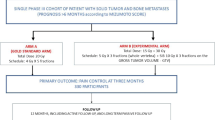Abstract
Purpose
The purpose of this study was to determine the incidence of pain flare (PF) in patients receiving spine stereotactic body radiotherapy (SBRT) treated with prophylactic oral dexamethasone (DEX) 1 h before and for 4 days following SBRT.
Methods
Forty-seven patients were accrued on this prospective observational study. The first cohort of 24 patients was treated with 4 mg, while a second cohort of 23 patients treated with 8 mg of DEX. The Brief Pain Inventory (BPI) was used to score pain and functional interference each day during SBRT and for 10 days following. Comparisons between the 4 and 8 mg cohorts, in addition to our previously reported steroid naïve patients post SBRT (n = 41), were also performed.
Results
The total incidence of PF was 19 % (9/47). The incidence in the 4 and 8 mg cohorts was 25 % (6/24) and 13 % (3/23), respectively, and the difference was not statistically significant (p = 0.46). Comparing functional interference, the 4 mg cohort had better profile in walking ability (p < 0.005) and relationships with others (p < 0.035) compared to the 8 mg cohort. Compared to our previously reported steroid naïve cohort, prophylactic DEX significantly reduced the incidence of PF (68 vs. 19 %, p < 0.0001, respectively), patients had lower worst pain scores, and improved general activity interference outcome.
Conclusion
We recommend prophylactic DEX for patients treated with spine SBRT. Our current practice is based on the 4 mg protocol primarily due to the improved functional interference outcomes. A randomized trial is required to finalize the optimal regimen and schedule.


Similar content being viewed by others
References
Sahgal A, Bilsky M, Chang EL et al (2011) Stereotactic body radiotherapy for spinal metastases: Current status, with a focus on its application in the postoperative patient. J Neurosurg Spine 14(2):151–66. doi:10.3171/2010.9.SPINE091005
Sahgal A, Chou D, Ames C et al (2007) Image-guided robotic stereotactic body radiotherapy for benign spinal tumors: the university of california san francisco preliminary experience. Technol Cancer Res Treat 6(6):595–604
Sahgal A, Larson DA, Chang EL (2008) Stereotactic body radiosurgery for spinal metastases: a critical review. Int J Radiat Oncol Biol Phys 71(3):652–65. doi:10.1016/j.ijrobp.2008.02.060
Sahgal A, Roberge D, Schellenberg D et al (2012) The Canadian association of radiation oncology scope of practice guidelines for lung, liver and spine stereotactic body radiotherapy. Clin Oncol (R Coll Radiol) 24(9):629–39. doi:10.1016/j.clon.2012.04.006
Lo SS, Sahgal A, Chang EL et al (2013) Serious complications associated with stereotactic ablative radiotherapy and strategies to mitigate the risk. Clin Oncol (R Coll Radiol) 25(6):378–87. doi:10.1016/j.clon.2013.01.003
Sahgal A, Weinberg V, Ma L et al (2013) Probabilities of radiation myelopathy specific to stereotactic body radiation therapy to guide safe practice. Int J Radiat Oncol Biol Phys 85(2):341–7. doi:10.1016/j.ijrobp.2012.05.007
Sahgal A, Ma L, Weinberg V et al (2012) Reirradiation human spinal cord tolerance for stereotactic body radiotherapy. Int J Radiat Oncol Biol Phys 82(1):107–16. doi:10.1016/j.ijrobp.2010.08.021
Sahgal A, Ma L, Gibbs I et al (2010) Spinal cord tolerance for stereotactic body radiotherapy. Int J Radiat Oncol Biol Phys 77(2):548–53. doi:10.1016/j.ijrobp.2009.05.023
Sahgal A, Atenafu EG, Chao S et al (2013) Vertebral compression fracture after spine stereotactic body radiotherapy: a multi-institutional analysis with a focus on radiation dose and the spinal instability neoplastic score. J Clin Oncol 31(27):3426–31. doi:10.1200/JCO.2013.50.1411
Cunha MV, Al-Omair A, Atenafu EG et al (2012) Vertebral compression fracture (VCF) after spine stereotactic body radiation therapy (SBRT): Analysis of predictive factors. Int J Radiat Oncol Biol Phys 84(3):e343–9. doi:10.1016/j.ijrobp.2012.04.034
Chiang A, Zeng L, Zhang L et al (2013) Pain flare is a common adverse event in steroid-naive patients after spine stereotactic body radiation therapy: a prospective clinical trial. Int J Radiat Oncol Biol Phys 86(4):638–42
Cleeland CS, Ryan KM (1994) Pain assessment: Global use of the brief pain inventory. Ann Acad Med Singap 23(2):129–38
Hird A, Wong R, Flynn C et al (2009) Impact of pain flare on patients treated with palliative radiotherapy for symptomatic bone metastases. J Pain Manag 4(2):401–6
Chow E, Loblaw A, Harris K (2007) Dexamethasone for the prophylaxis of radiation-induced pain flare after palliative radiotherapy for bone metastases: a pilot study. Support Care Cancer 15(6):643–7
Wang XS, Rhines LD, Shiu AS et al (2012) Stereotactic body radiation therapy for management of spinal metastases in patients without spinal cord compression: a phase 1–2 trial. Lancet Oncol 13(4):395–402. doi:10.1016/S1470-2045(11)70384-9
Walker PW, Palla S, Pei BL et al (2008) Switching from methadone to a different opioid: what is the equianalgesic dose ratio? J Palliat Med 11(8):1103–8. doi:10.1089/jpm.2007.0285
Hird A, Zhang L, Holt T et al (2009) Dexamethasone for the prophylaxis of radiation-induced pain flare after palliative radiotherapy for symptomatic bone metastases: a phase II study. Clin Oncol (R Coll Radiol) 21(4):329–35. doi:10.1016/j.clon.2008.12.010
Pan HY, Allen PK, Wang XS et al (2014) Incidence and predictive factors of pain flare after spine stereotactic body radiation therapy: Secondary analysis of phase 1/2 trials. Int J Radiat Oncol Biol Phys. doi:10.1016/j.ijrobp.2014.07.037
Acknowledgments
None
Conflict of interests
Dr. Arjun Sahgal has received honorarium for previous educational seminars for Medtronic Kyphoplasty division and for Elekta AB and has research grants from Elekta AB, otherwise, there are no conflicts of interest to disclose.
Author information
Authors and Affiliations
Corresponding author
Rights and permissions
About this article
Cite this article
Khan, L., Chiang, A., Zhang, L. et al. Prophylactic dexamethasone effectively reduces the incidence of pain flare following spine stereotactic body radiotherapy (SBRT): a prospective observational study. Support Care Cancer 23, 2937–2943 (2015). https://doi.org/10.1007/s00520-015-2659-z
Received:
Accepted:
Published:
Issue Date:
DOI: https://doi.org/10.1007/s00520-015-2659-z




